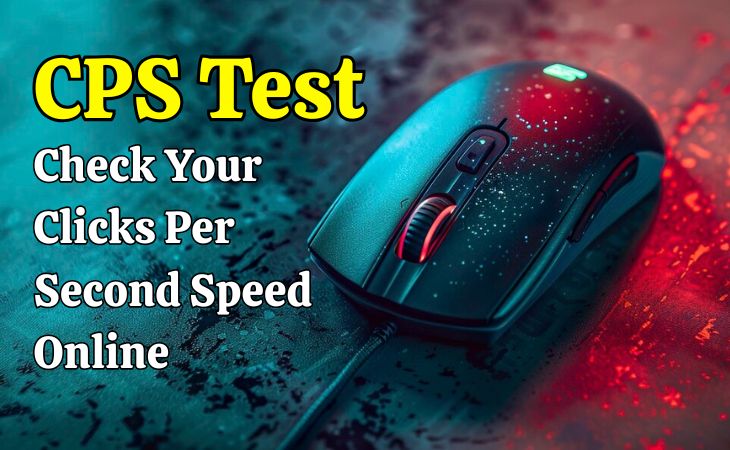
The CPS Test measures the number of times you can quickly and consistently click your mouse button in a set amount of time. The most common duration for this click test is 5 seconds, but some variations include 10, 30, and even 60-second intervals. The result is usually displayed as a number representing the average clicks per second (CPS).
How Does the CPS Test Work?
The CPS Test is straightforward. Here’s a step-by-step guide on how it typically works:
- Start the Test: You visit a ClickSpeedTest.net website that offers the CPS Tester. There’s usually a large button labeled “Click Here to Start Playing.”
- Clicking Phase: Once you click the start button, a timer begins, and you start clicking as fast as you can. Each click is recorded by the software.
- Time’s Up: After the set time interval (usually 5 seconds), the clicks per second test stops automatically.
- Results: The software calculates the number of clicks and divides it by the number of seconds to give you an average CPS test score. For example, if you clicked 25 times in 5 seconds, your CPS score would be 5.
Benefits of Using a CPS Test
There are several reasons why someone might use a Clicks Per Second Test. Here are some of the key benefits:
1. Improves Gaming Skills
For gamers, particularly those who play fast-paced games like first-person shooters (FPS), having a high test cps can be crucial. Quick reflexes and fast clicking can give you a significant advantage over your opponents.
2. Enhances Typing and Clicking Speed
For professionals who spend a lot of time on computers, improving your clicking speed can enhance your productivity. Faster clicking means quicker navigation through tasks, whether you’re coding, designing, or just browsing the web.
3. Fun and Competitive
The CPS Test can also be a fun way to challenge your friends or coworkers. Many people enjoy competing to see who can achieve the highest CPS score. This can make for an engaging and entertaining break activity.
4. Measures Progress
If you’re trying to improve your clicking speed, regularly taking the Click Speed Test can help you track your progress. Seeing your score improve over time can be a great motivator.
5. Stress Relief
For some, the act of rapid clicking can be a stress reliever. The focus and repetition can take your mind off worries and help you relax.
How to Get Better at the CPS Test
Improving your CPS score can take practice and some techniques. Here are a few tips to help you click faster:
1. Proper Hand Position
Ensure your hand is positioned comfortably on the mouse. Your fingers should be relaxed, and you should be able to click without straining.
2. Use Both Hands
If the test allows, use both hands to click. This can significantly increase your speed as you alternate between fingers.
3. Stay Relaxed
Tension can slow you down. Try to stay relaxed and keep a steady rhythm while clicking.
4. Practice Regularly
Like any skill, regular practice can help you improve. Set aside a few minutes each day to practice clicking as fast as you can.
5. Use a Good Mouse
A responsive mouse can make a big difference. Ensure you’re using a mouse that is comfortable and has good click response.
Different Variations of CPS Tests
While the standard CPS Test is for 5 seconds, there are several variations you can try:
- 10-Second CPS Test: Gives a slightly longer interval to test your endurance and speed.
- 30-Second CPS Test: A more extended test that can challenge your consistency and stamina.
- 60-Second CPS Test: The longest standard test, ideal for measuring sustained clicking ability.
Each variation can help you gauge different aspects of your clicking speed and endurance.
CPS Test and Health Considerations
While taking the Clicking Speed Test can be fun and beneficial, it’s important to be mindful of your health. Here are a few considerations:
1. Avoid Strain
Rapid clicking for extended periods can strain your fingers and wrist. Ensure you take regular breaks and don’t overdo it.
2. Ergonomics
Maintain a good posture while clicking. Your desk and chair should be set up to support your arms and back properly.
3. Listen to Your Body
If you experience pain or discomfort, stop immediately. It’s not worth risking injury for a higher CPS score.
FAQs
Q1. What is the CPS Test?
The CPS Test measures how many times you can click your mouse in a set time, usually 5 seconds. It calculates your average clicks per second, known as CPS.
Q2. Why should I take the CPS Test?
The CPS Test helps improve gaming reflexes, clicking speed, and overall productivity. It’s also fun and can track progress or serve as a friendly competition among users.
Q3. How can I improve my CPS score?
To improve CPS, practice regularly, stay relaxed, use a responsive mouse, and maintain proper hand positioning. Some users also try advanced clicking methods like jitter or butterfly clicking.
Q4. Are there different types of CPS Tests?
Yes, CPS Tests can be taken in various durations like 5, 10, 30, or 60 seconds. Each version helps test your clicking speed, stamina, and consistency in different ways.
Q5. Is it safe to take the CPS Test regularly?
Yes, it’s generally safe if done in moderation. Always take breaks, use good posture, and stop if you feel any pain or strain in your fingers or wrist.
Conclusion
The CPS Test is a fantastic tool for measuring and improving your clicking speed. Whether you’re a gamer looking to gain an edge, a professional seeking to boost productivity, or just someone who enjoys a fun challenge, the click test offers a range of benefits. With regular practice and proper technique, you can see your CPS score improve over time. Remember to stay mindful of your health and enjoy the process of getting faster and more efficient. Happy clicking!